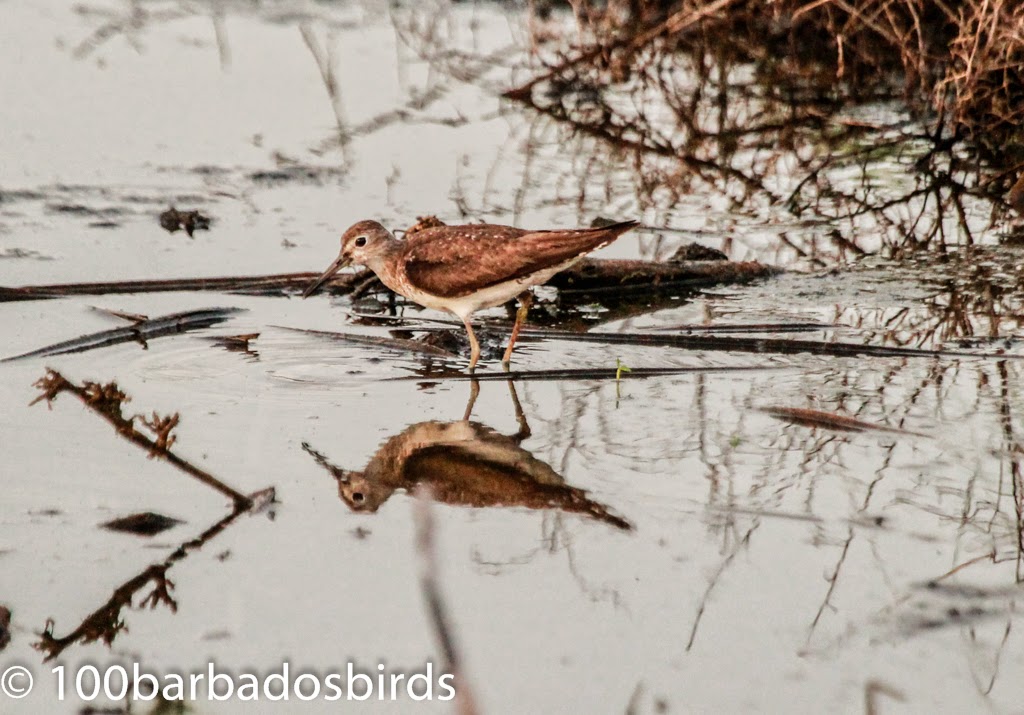The Woodbourne Shorebird Refuge (WSR) was badly affected by
this prolonged dry spell we were/are having on the island. Unlike the private hunting compounds, which
pumped water in to create artificial wetlands, the WSR depends on rain as its
source of water. As a result of the low
rainfall, the site was dry for most of the southern (autumn) migration season -
robbing migrating shorebirds of a safe haven away from the blazing guns of
hunters. This all changed with the passing
of a number of tropical systems. The
site now has a small fraction of its water capacity but is already teaming with
avian life.

I visited the WSR on the 17th October, 2014 at
about 5pm and recorded 23 species of birds. The highlight of my visit was a close up
encounter with a Yellow-crowned Night Heron. This has been the only place in Barbados that
I have ever seen this bird, earlier this year I recorded two of them, a lifer
for me then. The bird stood motionless
on the bank of one of the trays which allowed me to observe it for a while.
I also saw my first Blue-winged Teal for the southern (Autumn)
migration season. A flock of eighteen
birds were hiding among the vegetation in the pond.
From a layman’s view point I believe that the Shorebird Conservation
Trust - the charity which among other things looks after the WSR - should
be given the resources to have at least sufficient water for the period of the
hunting season. I personally would also
like to see two more Shorebird Refuges established one at the old hunting
compounds at Coles, St. Philip on the East Coast and the other at North Point, St.
Lucy on the North Coast. This would be a
huge benefit to shorebird conservation.
|
Common
Names
|
Scientific
Names
|
|
Blue-winged Teal
|
Anas discors
|
|
Little Egret
|
Egretta garzetta
|
|
Green Heron
|
Butorides virescens
|
|
Black-crowned Night Heron
|
Nycticorax nycticorax
|
|
Yellow-crowned Night Heron
|
Nyctanassa violacea
|
|
Common Gallinule
|
Gallinula galeata
|
|
Semipalmated Plover
|
Charadrius semipalmatus
|
|
Spotted Sandpiper
|
Actitis macularius
|
|
Solitary Sandpiper
|
Tringa solitaria
|
|
Greater Yellowlegs
|
Tringa melanoleuca
|
|
Lesser Yellowlegs
|
Tringa flavipes
|
|
Least Sandpiper
|
Calidris minutilla
|
|
White-rumped Sandpiper
|
Calidris fuscicollis
|
|
Pectoral Sandpiper
|
Calidris melanotos
|
|
Semipalmated Sandpiper
|
Calidris pusilla
|
|
Wilson's Snipe
|
Gallinago delicata
|
|
Scaly-naped Pigeon
|
Patagioenas squamosa
|
|
Common Ground-Dove
|
Columbina passerina
|
|
Zenaida Dove
|
Zenaida aurita
|
|
Gray Kingbird
|
Tyrannus dominicensis
|
|
Black-faced Grassquit
|
Tiaris bicolor
|
|
Barbados Bullfinch
|
Loxigilla barbadensis
|
|
Carib Grackle
|
(Quiscalus lugubris)
|






































